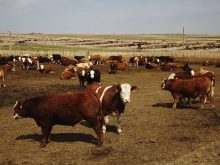MOOSE JAW, Sask. – The Canadian cattle industry will emerge from the current downturn stronger than ever, says the co-chief executive officer of XL Foods Inc.
Brian Nilsson told the Saskatchewan Stock Growers Association annual convention last week that the Canadian marketplace is developing its own identity and will bring premiums.
“My brother Lee and me have one mission and that is that nobody is going to ship cattle to the States when we’re done because they should be worth more here,” he said.
“We want to kill them all. We want to process them. And that’s our goal.”
Read Also

Lending policy still focused on primary producers: Farm Credit Canada
Farm Credit Canada said it has not changed its business practices and remains committed to supporting all producers, after a report from an Ottawa-based media outlet claimed otherwise.
Nilsson told reporters that the next six months will still be tough as the industry rides out the higher Canadian dollar but the long-term prospects are good.
Two fundamental changes led Nilsson to his conclusion. The herd contraction is a continuing response to the high populations retained after BSE, he said, and there is still some distance to go. However, he believes the bottom is near as he sees heifers go back into breeding herds rather than into feedlots.
“One of the things that has come out of that contraction is that we believe that the export market, both for feeder and for fed cattle, will play less influence in the marketplace in general,” he said.
Right now, 70 percent of the meat sold from Canadian plants goes to the domestic marketplace, he said. A little more contraction and that will rise to 80 percent and make the Canadian market even stronger.
Nilsson said the last 45 days have shown that to be the case.
The other shift is the development of a triple A market in Canada. Traditionally, U.S. retailers didn’t recognize triple A as choice and packers had to downgrade that product if selling into the American market.
“We are changing right now to where we actually have a premium in Canada for our triple A product,” Nilsson explained. “Our choice-select spread is wider here and that is going to bring some changes.
“We believe that our marketplace will actually start to be in a strange way a little more American in the sense that we will have choice premiums and we will, long-term, develop that market in Canada.”
XL Foods is developing a grid program to recognize quality. Nilsson said cattle prices will be higher because the packer can sell the meat for more money.
Meanwhile, the American market is going the other way and choice product has actually been selling for less than select, he said. The two markets will eventually meet in the middle.
Nilsson is unapologetic about his support and desire for a stronger domestic market, but said he is not on the same page as the National Farmers Union in terms of a supply managed sector. He said losing 20 percent of the cow herd simply dictates a smaller industry and greater role for the domestic market.
“In our heart, we’re domestic guys,” he said. “We really believe the best market we have in Canada is Canada.
“If you think you’re going to build your industry on selling it somewhere else, you will be disappointed.”
However, he said there are great opportunities to export what Canadians don’t eat – offal, tongue and liver, for example – to countries that are willing to pay for it.
There has to be a balance, he added.
“We firmly support exports but we do not support them in the sense that we’re not paying attention to our domestic market at the same time.”















